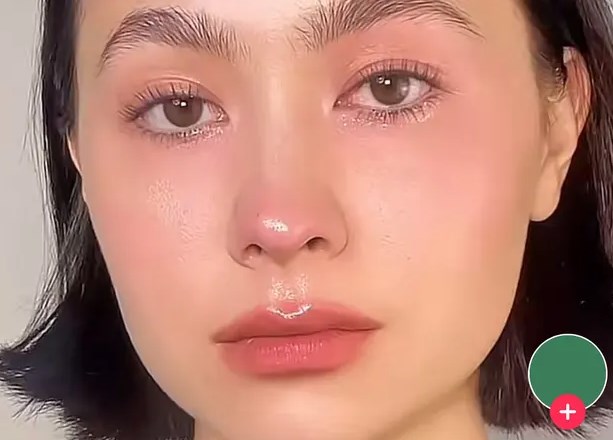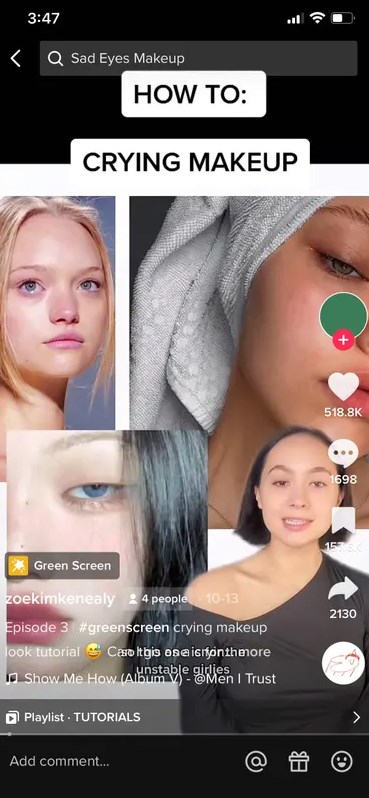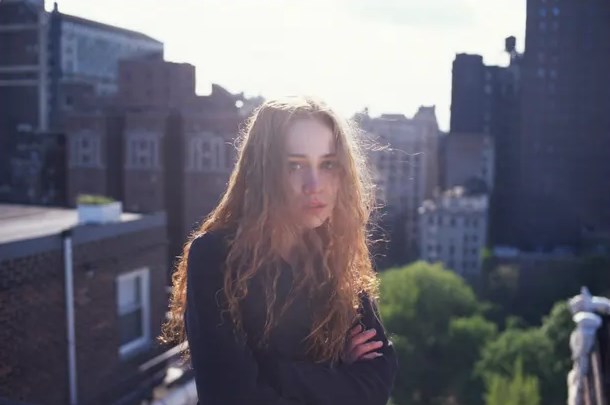‘Sadness is a TikTok trend’
Beauty magazines once taught readers how to use makeup to conceal a recent sobbing sesh. But now, one TikTok trend encourages us to embrace those misty eyes and rosy noses. “Crying makeup,” it seems, is in.
In a clip that has gained over 507,000 likes, the Boston-based content creator Zoe Kim Kenealy offers a tutorial “for the unstable girlies” to achieve the look of a fresh sob even “if you’re not in the mood to cry”.
She starts with a glob of gloss for “that puffy, soft, lip”, then a swipes red shadow around the eyes, and finally applies glitter eyeliner all around her face for some “shine”. “I want to look like I’m pretty crying all of the time,” one viewer commented. “I feel so pretty after I cry,” wrote another. “I can’t tell if it’s the eye lashes or red nose.”
Kenealy, who is 26 and has 119,000 TikTok followers, told the Guardian she was inspired by two east Asian makeup trends: Douyin and Ulzzang. Both genres involve ample amounts of blush, glitter and the highlighting the under-eye area for an overall cherubic effect.
“It’s inspired by the twinkle in your eye you get after you cry,” said Kenealy. She stresses the look is just an aesthetic, not dishonesty. “People – mostly men – have been commenting ‘Amber Heard’ on my video,” she said, referring to the hordes of Johnny Depp TikTok fans who believe his ex-wife fake-cried on the stand about his alleged abuse. “It’s a makeup look I wouldn’t necessarily wear outside. It’s not meant to deceive anyone.”
Misery, or at least the performance of it, is all over TikTok – probably because it’s all over the real world, too. In a 2021 Harvard Youth Poll, more than half of young Americans said they had felt “down, depressed, or hopeless” in the past seven days.
And in an era of global wars, rampant racism, an unchecked climate crisis and mass loneliness, a simple red lip no longer suffices. Instead, beauty trends have emerged to match the malaise of today. There’s “dissociative pout”, which i-D called a “lobotomy-chic, dead-eyed” younger sister to the now-passé duck lips that had 2010s influencers in a chokehold. You can see it in the doll-like online posturing of Euphoria’s breakout waif Chloe Cherry, or the spaced-out stare on Olivia Rodrigo’s Instagram page.
Any walk can be a #SadGirlWalk if you listen to Lana Del Rey and gaze longingly in the distance. The hashtag, with over 504,000 views, features videos of young women looking somber while toting iced lattes and showing off their outfits. “Let me cry to Taylor Swift while walking until I can’t anymore,” one user commented on their clip.
Fredrika Thelandersson, a postdoctoral researcher in media and communications studies at Sweden’s Lund University and author of the new book 21st Century Media and Female Mental Health, studies online girl cultures and communities.
“In the current landscape, celebrities and brands want to have authenticity, to appear real,” she said. “One way to do this is to disclose a diagnosis or reveal a trauma. It’s literally profitable to show some kind of vulnerability.”
This trickles down through TikTok, Thelandersson explained, diluting the meaning of medical and psychological language. “Dissociation is a symptom of PTSD, and now it’s being picked up as an aesthetic,” she said. “This says a lot about how people are not doing so well right now and need support, and social media becomes the place where they can find what they wouldn’t get from a traditional healthcare system.”
And what if someone is faking their sadness with faux tears or a phony, far-off look?
“Maybe it is performing sad feelings, but there is a communal aspect when you realize that other people feel the same way, and that’s a sort of belonging,” Thelandersson said. “You can make fun of that as much as you want, but it’s still kind of hopeful in a way.”
Gen Z isn’t the first generation to discover oversharing’s louche allure – Gen X icons like Fiona Apple, Courtney Love and the late Elizabeth Wurtzel all made careers out of it in the 90s. The writer Emily Gould got her start in the early-aughts blogging boom, with overly candid entries that often fell in the love-to-hate category. Emo acts like Paramore and My Chemical Romance dominated 2010s music charts, with confessional lyrics and a goth-adjacent look of swoopy side bangs and dramatically dark eye makeup.
Audrey Wollen, the writer who coined the term “Sad Girl Theory” in 2014, gained internet fame through her proposal that being sad publicly is a legitimate form of protest against the patriarchy (though Wollen’s archetype of the chronically online Tumblr girl was usually implied to be white, thin, conventionally attractive and independently wealthy).
But this time around, TikTok’s massive reach (nearly 1 billion users in 150 countries) is helping the trend spread at an unprecedented rate. “I think some of this is just teenagers having way too much access to the internet,” InStyle’s beauty writer Tamim Alnuweiri said. “When I was a teenager, I also stuck my head against the window and pretended I was in a music video when it was raining, but their version of this is much more public.”
Kelly Cutrone, the PR legend who founded the firm People’s Revolution and appeared on The Hills, The City and America’s Next Top Model, once wrote a book of career advice called If You Have to Cry, Go Outside. “It taught people how to deal with their emotions in the workplace,” she said. “It’s pretty sad that sadness would be a trend. But I have a 20-year-old, and those kids all went through hell [during the pandemic].”
Cutrone invented her own term to describe the kids she sees in clubs lately: “nocturnal romance”. Think “zombie dark angel vibes: half-naked kids who look strung out, with these weird, gazing stares”.
They’re “creatures of the night”, Cutrone added, riffing off Julia Fox, the doe-eyed fashion darling who’s often seen roaming the streets of New York in low-cut jeans, Balenciaga bodysuits, and layers of thick black eyeliner. “She has this posse of girls who come to my events sometimes and they’re quite the it girls,” Cutrone said. “The it girls are no longer Twiggy: they’re Elvira.”
Post time: Nov-01-2022




